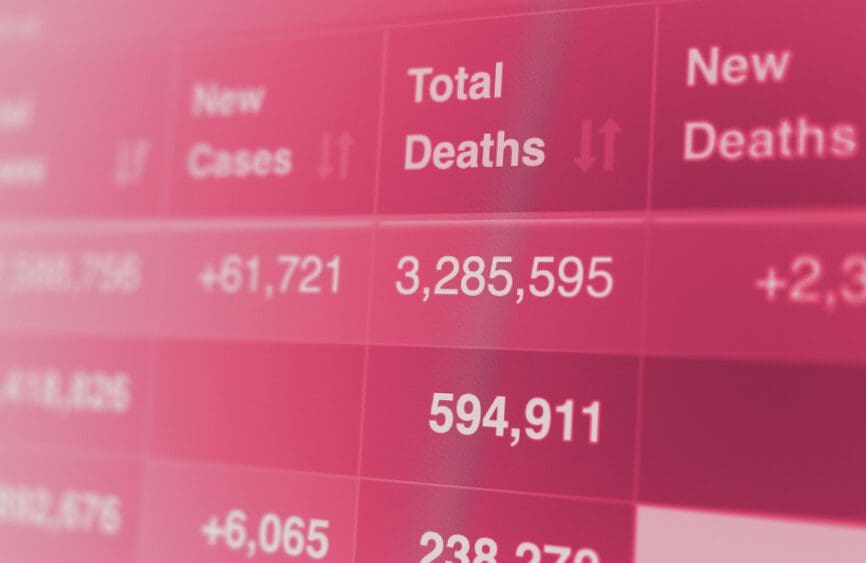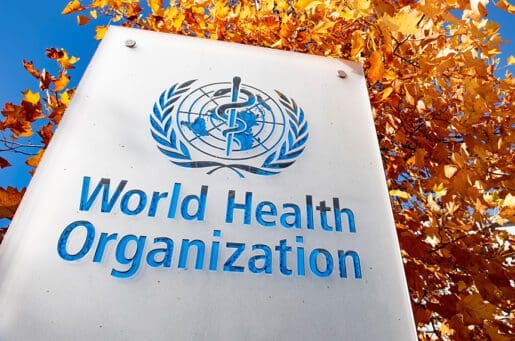Bioethics Forum Essay
How Many Covid-19 Deaths Should We Accept?
President Biden recently declared that the Covid-19 “pandemic is over.” Some public health experts agreed with this assessment; others disagreed. What cannot be disputed is that nearly 12,000 Americans have died from Covid-19 over the past 28 days. While the current behavior of Americans suggests they are willing to accept 400 to 500 Covid deaths per day, we would argue that is ethically unacceptable.
How many Covid deaths are acceptable? This is an important normative question, but it is challenging to contemplate and address.
One possible answer is that our goal should be no preventable deaths. This might be endorsed as morally ideal; however, realizing, or approximating, such an ideal is not practically possible, or even reasonable, from a policy perspective. China’s zero-Covid approach has, for instance, greatly disrupted everyday life—a dubious coercive strategy that would never be accepted in a liberal-democratic country.
Another possibility is to treat preventing the spread of SARS-CoV-2 as a matter of personal responsibility, such that individuals should be free to choose, for example, whether to be vaccinated or to mask. Yet, this stance fails to recognize that there are ethically appropriate constraints on personal liberty. Moreover, it is antithetical to legitimate public health policy, which cannot be sustained by appeals to personal responsibility alone. Some vulnerable groups will disproportionately bear the health consequences if matters of public health are left to personal choices. Some individuals lack the means, such as paid sick leave or the ability to work remotely to meaningfully protect themselves and their families. Thus, such a position unjustly abdicates the governmental responsibility to protect the health and well-being of the population, particularly the worse off.
How, then, can we approach the challenge of identifying an acceptable level of deaths from Covid-19? Some guidance for navigating between the two extremes is available from examination of other contexts in which, implicitly if not explicitly, policymakers and the public accept tradeoffs between lives, on the one hand, and costs and inconveniences on the other.
First, consider automobile safety. In 2021, more than 42,000 people in the United States died in motor vehicle accidents. By law, cars must be equipped with safety features like airbags, and drivers must wear seatbelts and adhere to speed limits. But if maximum speed limits were reduced (and enforced), many fewer deaths would occur. Automobile safety law illustrates a tradeoff between lives on the one hand and time saved in faster trips on the other. To look at another example, alcohol consumption is the single greatest cause of motor vehicle fatalities. Changing state laws to reduce the legal blood alcohol concentration limit for driving from .08 to .05 would be an effective means to reduce alcohol-related injury and death; yet, states have largely resisted such measures.
Second, we could look to deaths from influenza—a more natural comparator than cars. While Covid-19 and flu are both contagious respiratory illnesses, there are important dissimilarities; throughout the pandemic, however, people have drawn this comparison. The U.S. Centers for Disease Control and Prevention estimates that from 2010 to 2020, influenza caused between 12,000 and 52,000 deaths annually. Flu vaccines are readily available—though their efficacy is considerably lower than for Covid-19 and varies year to year, and only approximately half of the population receives them. There are few flu vaccine mandates (i.e., only for select groups, like hospital staff), and no mask mandates; the economy does not shut down for flu. At the current seven-day average of 481 Covid deaths, the annual total would be 175,565, more than three times a high level of annual flu deaths.
The point is not that we should accept tens of thousands of deaths from Covid-19. We should not uncritically take the annual death rate accepted in the context of driving or influenza and assume it is normatively acceptable. People have argued that more restrictions could—and should—be adopted to save more lives from accidents and influenza. However, as a reflection of policy deliberations seeking to balance the risks and benefits of public health interventions, the numbers of automobile and flu deaths annually offer quantitative benchmarks for thinking about the acceptable number of deaths from Covid-19. They clearly indicate that the current level of deaths from Covid-19 is unacceptable.
What counts as ethically acceptable must be seen as relative to feasible measures of prevention, including: how substantial the harm avoided is, the measures’ cost-effectiveness, the extent to which they interfere with people’s lives and liberties, and whether less-restrictive alternatives could achieve similar benefits.
The rapid development of safe and effective vaccines has been a major public health achievement. However, in the U.S. approximately 32% of the population has not completed their primary vaccination series, and 65% of those over age 5 have not received even one booster. Vaccine mandates—at least for select populations—to reduce preventable deaths are justifiable. Masks are highly protective. Failure to use safe and effective public health tools that do not pose undue burdens leads to a substantial, and ethically problematic, level of hospitalizations and deaths.
One notable issue is that public health policy concerns “statistical” rather than “identifiable” lives. While people might be willing to act to protect their own lives and those of their friends or family members, it can be more difficult to motivate them to act to save the lives of others they will never meet or know. This has been a recognized challenge of communication throughout the pandemic: if lives are saved by measures like encouraging or mandating vaccination and masking, we will not know which lives. People may well think (because they don’t bear the counterfactual in mind) that these efforts were unnecessary.
In a recent poll, nearly half of respondents indicated that they have already returned to their “normal, pre-COVID life.” But we would suggest that there is no returning to pre-Covid life. And it is irresponsible to ignore a virus that continues to destroy an outsized number of lives. There is only finding a new normal where we learn to live with SARS-CoV-2. Ideally, this would entail thoughtful public health policy that strives to undertake reasonable measures to minimize Covid deaths and renders explicit the tradeoffs made between hospitalizations and deaths and, for example, economic productivity, convenience, and liberty.
Emily A. Largent, JD, PhD, RN (@emily_a_largent), is an assistant professor of medical ethics and health policy at the University of Pennsylvania Perelman School of Medicine. Franklin G. Miller, PhD, is a professor of medical ethics in medicine at Weill Cornell Medical College, and a Hastings Center fellow and board member.













This is an important conversation to begin – not least because liberal democracies need to articulate an alternative to the attempt by the PRC to maintain a zero-Covid goal at whatever cost. However, it is not helped by the lack of evidence that would justify many of the non-pharmaceutical interventions that the authors have in mind. Encouraging vaccination is highly desirable – but the marginal returns from existing boosters and vaccine targets mean that the focus should be on outreach rather than further supply to already vaccinated groups. Genuine vaccine resistance seems to be rare compared with a failure by public health agencies to engage with socially excluded communities. The authors are entirely too sanguine about the evidence for the effectiveness of masks – it is hard ethically to justify compulsion or even explicit nudges when the science is highly contested. Even if there is a community benefit, it is likely to be small and ethicists need to consider the proportionality of the intervention. It may help some vulnerable groups but disadvantage others. Who has the greater moral claim? Who gets to decide? This paper is a good start but far from the last word.
How can this question be discussed without acknowledging the disproportionate mortality rates by race and ethnicity in the U.S.? These data are available from the CDC’s website and they are shocking, though not surprising. Who, then, is the “we” in the title? How is it possible that in 2022 this article can be published in a bioethics journal without addressing racial and ethnic disparities? The authors discuss “vulnerable groups” and those who “lack the means,” but without mention of how racism structures who those groups are. Silence on this subject in an influential forum seems to me unethical in itself.